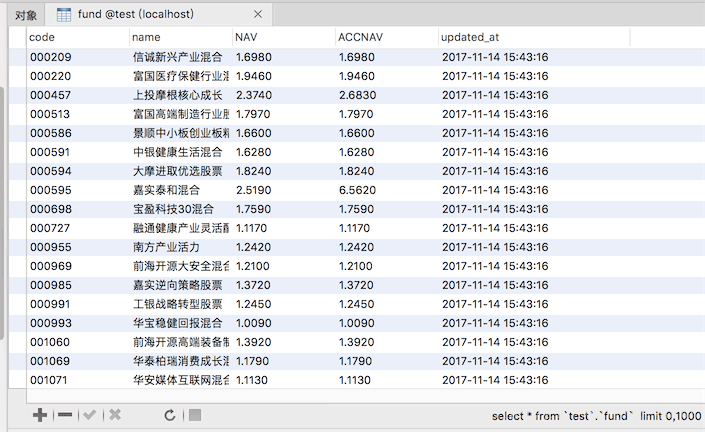您好,登錄后才能下訂單哦!
您好,登錄后才能下訂單哦!
本文實例講述了python和mysql交互操作。分享給大家供大家參考,具體如下:
python要和mysql交互,我們利用pymysql這個庫。
下載地址:
https://github.com/PyMySQL/PyMySQL
安裝(注意cd到我們項目的虛擬環境后):
cd 項目根目錄/abc/bin/ #執行 ./python3 -m pip install pymysql
稍等片刻,就會把pymysql庫下載到項目虛擬環境abc/lib/python3.5/site-packages中。(注意我項目是這個路徑,你的不一定)
文檔地址:
http://pymysql.readthedocs.io/en/latest/
使用:
import pymysql.cursors
# 連接數據庫
connection = pymysql.connect(host='localhost',
user='root',
password='root',
db='test',
charset='utf8mb4',
cursorclass=pymysql.cursors.DictCursor)
try:
with connection.cursor() as cursor:
# Read a single record
sql = "SELECT * From news"
cursor.execute(sql)
result = cursor.fetchone()
print(result) # {'id': 1, 'title': '本機新聞標題'}
finally:
connection.close()
我們連上了本地數據庫test,從news表中取數據,數據結果為{'id': 1, 'title': '本機新聞標題'}

返回的結果是字典類型,這是因為在連接數據庫的時候我們是這樣設置的:
# 連接數據庫
connection = pymysql.connect(host='localhost',
user='root',
password='root',
db='test',
charset='utf8mb4',
cursorclass=pymysql.cursors.Cursor)
我們把cursorclass設置的是:pymysql.cursors.DictCursor。
字典游標,所以結果集是字典類型。
我們修改為如下:
cursorclass=pymysql.cursors.Cursor
結果集如下:
(1, '本機新聞標題')
變成了元組類型。我們還是喜歡字典類型,因為其中包含了表字段。
Cursor對象
主要有4種:
Cursor 默認,查詢返回list或者tuple
DictCursor 查詢返回dict,包含字段名
SSCursor 效果同Cursor,無緩存游標
SSDictCursor 效果同DictCursor,無緩存游標。
插入
try:
with connection.cursor() as cursor:
sql = "INSERT INTO news(`title`)VALUES (%s)"
cursor.execute(sql,["今天的新聞"])
# 手動提交 默認不自動提交
connection.commit()
finally:
connection.close()
一次性插入多條數據
try:
with connection.cursor() as cursor:
sql = "INSERT INTO news(`title`)VALUES (%s)"
cursor.executemany(sql,["新聞標題1","新聞標題2"])
# 手動提交 默認不自動提交
connection.commit()
finally:
connection.close()
注意executemany()有別于execute()。
sql綁定參數
sql = "INSERT INTO news(`title`)VALUES (%s)" cursor.executemany(sql,["新聞標題1","新聞標題2"])
我們用%s占位,執行SQL的時候才傳遞具體的值。上面我們用的是list類型:
["新聞標題1","新聞標題2"]
可否用元組類型呢?
cursor.executemany(sql,("元組新聞1","元組新聞2"))
同樣成功插入到數據表了。
把前面分析得到的基金數據入庫
創建一個基金表:
CREATE TABLE `fund` ( `code` varchar(50) NOT NULL, `name` varchar(255), `NAV` decimal(5,4), `ACCNAV` decimal(5,4), `updated_at` datetime, PRIMARY KEY (`code`) ) COMMENT='基金表';
準備插入SQL:
注意%(code)s這種占位符,要求我們執行這SQL的時候傳入的參數必須是字典數據類型。
MySQL小知識:
在插入的時候如果有重復的主鍵,就更新
insert into 表名 xxxx ON duplicate Key update 表名
我們這里要準備執行的SQL就變成這樣了:
INSERT INTO fund(code,name,NAV,ACCNAV,updated_at)VALUES (%(code)s,%(name)s,%(NAV)s,%(ACCNAV)s,%(updated_at)s) ON duplicate Key UPDATE updated_at=%(updated_at)s,NAV=%(NAV)s,ACCNAV=%(ACCNAV)s;
1、回顧我們前面分析處理的基金網站數據
//www.jb51.net/article/162452.htm
#...
codes = soup.find("table",id="oTable").tbody.find_all("td","bzdm")
result = () # 初始化一個元組
for code in codes:
result += ({
"code":code.get_text(),
"name":code.next_sibling.find("a").get_text(),
"NAV":code.next_sibling.next_sibling.get_text(),
"ACCNAV":code.next_sibling.next_sibling.next_sibling.get_text()
},)
最后我們是把數據存放在一個result的元組里了。
我們打印這個result可以看到:
元組里每個元素 都是字典。
看字典是不是我們數據表的字段能對應了,但還少一個updated_at字段的數據。
2、我們把分析的網頁數據重新處理一下
from datetime import datetime
updated_at = datetime.now().strftime("%Y-%m-%d %H:%M:%S")
result = () # 初始化一個元組
for code in codes:
result += ({
"code":code.get_text(),
"name":code.next_sibling.find("a").get_text(),
"NAV":code.next_sibling.next_sibling.get_text(),
"ACCNAV":code.next_sibling.next_sibling.next_sibling.get_text(),
"updated_at":updated_at
},)
3、最后插入的代碼
try:
with connection.cursor() as cursor:
sql = """INSERT INTO fund(`code`,`name`,`NAV`,`ACCNAV`,`updated_at`)VALUES (%(code)s,%(name)s,%(NAV)s,%(ACCNAV)s,%(updated_at)s)
ON duplicate Key UPDATE `updated_at`=%(updated_at)s,`NAV`=%(NAV)s,`ACCNAV`=%(ACCNAV)s"""
cursor.executemany(sql,result)
# 手動提交 默認不自動提交
connection.commit()
finally:
connection.close()

4、完整的分析html內容(基金網站網頁內容),然后插入數據庫代碼:
from bs4 import BeautifulSoup
import pymysql.cursors
from datetime import datetime
# 讀取文件內容
with open("1.txt", "rb") as f:
html = f.read().decode("utf8")
f.close()
# 分析html內容
soup = BeautifulSoup(html,"html.parser")
# 所有基金編碼
codes = soup.find("table",id="oTable").tbody.find_all("td","bzdm")
updated_at = datetime.now().strftime("%Y-%m-%d %H:%M:%S")
result = () # 初始化一個元組
for code in codes:
result += ({
"code":code.get_text(),
"name":code.next_sibling.find("a").get_text(),
"NAV":code.next_sibling.next_sibling.get_text(),
"ACCNAV":code.next_sibling.next_sibling.next_sibling.get_text(),
"updated_at":updated_at
},)
# 連接數據庫
connection = pymysql.connect(host='localhost',
user='root',
password='root',
db='test',
charset='utf8mb4',
cursorclass=pymysql.cursors.Cursor)
try:
with connection.cursor() as cursor:
sql = """INSERT INTO fund(`code`,`name`,`NAV`,`ACCNAV`,`updated_at`)VALUES (%(code)s,%(name)s,%(NAV)s,%(ACCNAV)s,%(updated_at)s)
ON duplicate Key UPDATE `updated_at`=%(updated_at)s,`NAV`=%(NAV)s,`ACCNAV`=%(ACCNAV)s"""
cursor.executemany(sql,result)
# 手動提交 默認不自動提交
connection.commit()
finally:
connection.close()
更多關于Python相關內容感興趣的讀者可查看本站專題:《Python常見數據庫操作技巧匯總》、《Python數學運算技巧總結》、《Python數據結構與算法教程》、《Python函數使用技巧總結》、《Python字符串操作技巧匯總》、《Python入門與進階經典教程》及《Python文件與目錄操作技巧匯總》
希望本文所述對大家Python程序設計有所幫助。
免責聲明:本站發布的內容(圖片、視頻和文字)以原創、轉載和分享為主,文章觀點不代表本網站立場,如果涉及侵權請聯系站長郵箱:is@yisu.com進行舉報,并提供相關證據,一經查實,將立刻刪除涉嫌侵權內容。